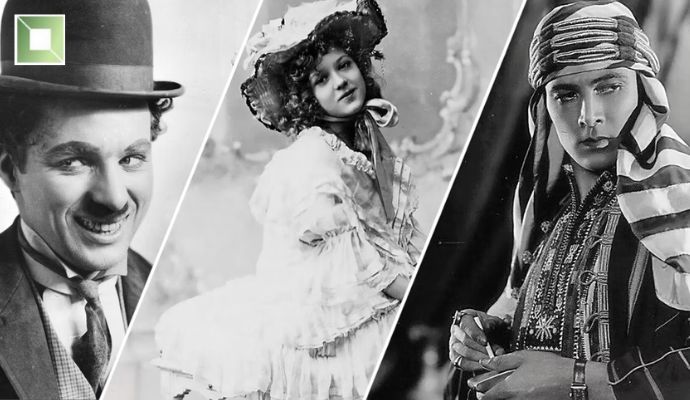Biggest Stars of the Quiet Film Era
Charlie Chaplin
On April 16, 1889, Charles Spencer Chaplin was born in London, England. His mother, Lily Harley, was a good-looking singer and actress who became well-known for her work in the light opera industry. His father was a skilled actor and singer.
Charlie and his brother Sydney had to fend for themselves before Charlie turned 10 years old due to the early loss of their father and the following illness of their mother. The children saw the platform as the best place to go after a career because they had become heirs to their parents’ natural gifts. As a member of the youth group “The Eight Lancashire Lads,” Charlie debuted his career and quickly gained recognition for his exceptional tap dancing.
Charlie Chaplin movies list
- Making a Living (1914):
- Kid Auto Races at Venice (1914):
- Mabel’s Strange Predicament (1914):
- A Thief Catcher (1914):
- Between Showers (1914):
- A Film Johnnie (1914):
- Tango Tangle (1914):
- His Favorite Pastime (1914):
Douglas Fairbanks
Douglas Elton Thomas Ullman, born Douglas Elton Fairbanks Sr., was born on May 23, 1883, and passed away on December 12, 1939. He was an American player and film producer who is most remembered for his bold parts in completely quiet films. Fairbanks rose to celebrity during the silent era and was known as “The King of Hollywood.”
In addition, he hosted the first educational institute awards in 1929 and founded the Motion Picture Education Association and United Producers. Fairbanks, born in Denver, Colorado, began performing at a young age and became well-known as a stage performer on Broadway by the late 1800s. After making his first cinematic appearance in 1915, he rose to fame as one of Hollywood’s most well-liked and highest-paid producers.
Douglas Fairbanks movies list
- The Thief of Bagdad (1924): I
- Robin Hood (1922):
- The Mark of Zorro (1920):
- The Iron Mask (1929):
- Don Q Son of Zorro (1925):
Buster Keaton
Producer, funnyman, and film director Joseph Frank “Buster” Keaton was born in America on October 4, 1895, and died on February 1, 1966. His quiet films from the 1920s, in which he performed creatively to good advantage and in a physically comical aspect, are what made him most famous.
The description “The Great Stone Face” came to him because of his habit of maintaining a deadpan and serious facial expression.
Keaton went on a trip with his family’s stage show as a young performer. As an adult, he started to get together with film producer Edward F. Cline and bold maker Joseph M. Schenck. Together, they made several popular two-reel comedies in the early 1920s, such as Cops (1922), The Playhouse (1921), One Week (1920), and The Electric House (1922).
Buster Keaton movies list
“The Butcher Boy” (1917):
“The Rough House” (1917):
“Neighbors” (1920):
“The Scarecrow” (1920):
“Cops” (1922):
“The Love Nest” (1923):
“The Balloonatic” (1923):
“The Gold Ghost” (1934):
“Allez Oop” (1934):
Clara Bow
American performer Clara Gordon Bow (July 29, 1905–September 27, 1965) became well-known in the 1920s quiet film era and made a soft transition to “talkies” in 1929. She gained worldwide identification and the nickname It Girl ” for her role as a strong salesgirl in the movie It. The bow is regarded as the essential sex character of the Roaring Twenties and came to act out the era. Bow starred in eleven talkies and 46 quiet images, incorporating famous films such as Mantrap (1926), Wings (1927), and It (1927). She was named the first box office put in 1928, 1929, and 1930, as well as in 1927.
Lillian Gish
American performer Lillian Diana Gish was born on October 14, 1893, and died on February 27, 1993. Her 75-year playing profession began in quiet movie house shorts in 1912 and ended in 1987. Gish is known as the “First Lady of American Cinema” and sticks something on with starting key methods for film acting. Lillian was named the 17th best female movie star in the history of classic Hollywood movie houses by the American Film Organization in 1999. Gish, who had performed on stage with her sister as a youngster, rose to celebrity as a movie star between 1912 and the 1920s, mostly in the works of D. W. Griffith. This is displayed in Griffith’s The Birth of a Nation (1915), the highest-earning quiet-era movie.
Mary Pickford
well-known by her stage name, Mary Pickford. The Biggest Stars of the Quiet Film Era, Gladys Louise Smith (April 8, 1892 – May 29, 1979) was a Canadian performer. Who lived in the United States and was also a playwright, producer, and author of a film studio. She had a five-decade Hollywood career and was a star in the American film industry.
Pickford co-founded Pickford-Fairbanks Studios and United Artists with her future husband, actor-producer Douglas Fairbanks. She was also among the 36 founders of the Education of Arts, Sciences, and Motion Images.
Once, ladies considered Pickford to be one of their most well-known members.During the quiet film era, she was recognized as “America’s Sweetheart.” On the AFI’s 100 Years… 100 Stars list, she ranked 24th among the top female stars of the Classical Hollywood movie house era.
Description
well-known by her stage name, Mary Pickford. The Biggest Stars of the Quiet Film Era, Gladys Louise Smith (April 8, 1892 – May 29, 1979)…
